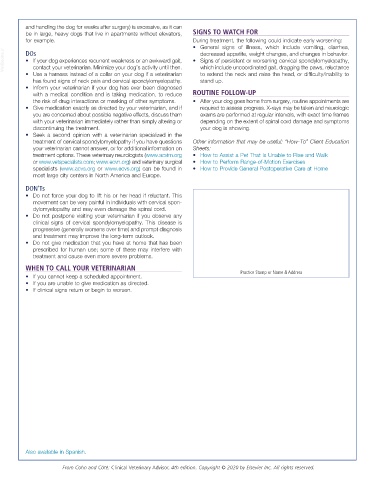Page 2956 - Cote clinical veterinary advisor dogs and cats 4th
P. 2956
and handling the dog for weeks after surgery) is excessive, as it can
be in large, heavy dogs that live in apartments without elevators, SIGNS TO WATCH FOR
for example. During treatment, the following could indicate early worsening:
• General signs of illness, which include vomiting, diarrhea,
VetBooks.ir • If your dog experiences recurrent weakness or an awkward gait, • Signs of persistent or worsening cervical spondylomyelopathy,
DOs
decreased appetite, weight changes, and changes in behavior.
which include uncoordinated gait, dragging the paws, reluctance
contact your veterinarian. Minimize your dog’s activity until then.
• Use a harness instead of a collar on your dog if a veterinarian to extend the neck and raise the head, or difficulty/inability to
has found signs of neck pain and cervical spondylomyelopathy. stand up.
• Inform your veterinarian if your dog has ever been diagnosed
with a medical condition and is taking medication, to reduce ROUTINE FOLLOW-UP
the risk of drug interactions or masking of other symptoms. • After your dog goes home from surgery, routine appointments are
• Give medication exactly as directed by your veterinarian, and if required to assess progress. X-rays may be taken and neurologic
you are concerned about possible negative effects, discuss them exams are performed at regular intervals, with exact time frames
with your veterinarian immediately rather than simply altering or depending on the extent of spinal cord damage and symptoms
discontinuing the treatment. your dog is showing.
• Seek a second opinion with a veterinarian specialized in the
treatment of cervical spondylomyelopathy if you have questions Other information that may be useful: “How-To” Client Education
your veterinarian cannot answer, or for additional information on Sheets:
treatment options. These veterinary neurologists (www.acvim.org • How to Assist a Pet That Is Unable to Rise and Walk
or www.vetspecialists.com; www.ecvn.org) and veterinary surgical • How to Perform Range-of-Motion Exercises
specialists (www.acvs.org or www.ecvs.org) can be found in • How to Provide General Postoperative Care at Home
most large city centers in North America and Europe.
DON’Ts
• Do not force your dog to lift his or her head if reluctant. This
movement can be very painful in individuals with cervical spon-
dylomyelopathy and may even damage the spinal cord.
• Do not postpone visiting your veterinarian if you observe any
clinical signs of cervical spondylomyelopathy. This disease is
progressive (generally worsens over time) and prompt diagnosis
and treatment may improve the long-term outlook.
• Do not give medication that you have at home that has been
prescribed for human use; some of these may interfere with
treatment and cause even more severe problems.
WHEN TO CALL YOUR VETERINARIAN
• If you cannot keep a scheduled appointment. Practice Stamp or Name & Address
• If you are unable to give medication as directed.
• If clinical signs return or begin to worsen.
Also available in Spanish.
From Cohn and Côté: Clinical Veterinary Advisor, 4th edition. Copyright © 2020 by Elsevier Inc. All rights reserved.

